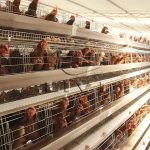Uganda’s poultry industry has grown rapidly in recent years as eggs and chicken meat continue to be important sources of affordable protein for millions of households. With increasing urbanization, rising incomes, and strong demand from hotels, restaurants, and local markets, commercial layer farming is becoming one of the most profitable agribusiness ventures in the country.
For farmers planning to expand their operations, investing in a 20,000-layer cage system is a smart step toward large-scale egg production. However, one of the biggest questions farmers often ask is: “How much do I need in Uganda to buy a 20,000 layer cage system?”
This article provides a detailed price guide, explains the factors that affect costs, and highlights the benefits of using a 20,000-capacity battery cage system in Uganda.

What Is a 20,000 Layer Cage System?
A layer cage system is a modern poultry housing structure designed to keep laying hens in organized rows of cages. For a 20,000-bird capacity, cages are usually arranged in 3-tier or 4-tier designs, depending on the farmer’s poultry house space and budget.
Most modern layer cages are integrated with:
- Automatic feeding systems to ensure consistent nutrition.
- Egg collection belts to reduce breakage and labor costs.
- Manure removal systems that keep the poultry house clean.
- Ventilation and climate control for healthier birds.
Compared to traditional deep litter methods, cage systems provide higher egg production, better hygiene, and easier management—making them ideal for commercial poultry farms in Uganda.
Cost of 20,000 Layer Cage in Uganda
The price of a 20,000-bird cage system in Uganda varies widely depending on the level of automation, material quality, and supplier.

Here is a general price estimate for Ugandan farmers:
- Manual 20,000-Layer Cage System:
(approx. $15,000 – $20,000 USD)- Basic cages without full automation. Feeding and egg collection are mostly manual.
- Semi-Automated 20,000-Layer Cage System:
(approx. $18,000 – $23,000 USD)- Includes features such as manure removal belts or automatic feeders.
- Fully Automated 20,000-Layer Cage System:
(approx. $23,000 – $30,000 USD)- Comes with feeding lines, egg collection conveyors, manure belts, and ventilation systems.
Prices may fluctuate depending on the supplier, shipping costs, and the Ugandan shilling exchange rate against the U.S. dollar. Farmers should always request a formal quotation before making a purchase.
Factors That Influence the Price
Several elements affect how much a farmer in Uganda will spend on a 20,000 layer cage system:
- Material Quality
- Hot-dip galvanized steel cages are more durable and rust-resistant, lasting up to 20 years.
- Electro-galvanized cages are cheaper but may rust faster in humid conditions.
- Automation Level
- Full automation is more expensive but reduces labor costs significantly.
- Semi-automated options provide a middle ground for farmers with medium budgets.
- Supplier Location
- Importing cages from international suppliers (China, Europe, or South Africa) may cost more initially but often ensures higher quality and durability.
- Transport & Installation
- Shipping from Mombasa port to Uganda adds costs due to inland transport.
- Installation and training fees also add to the total investment.
- Additional Equipment
- Farmers in Uganda’s hotter regions (such as northern districts) may require ventilation fans or cooling pads.
- In cooler regions, climate control may not be as expensive.

Why Invest in a 20,000-Layer Cage System?
Although the investment is significant, the long-term benefits make it worthwhile:
- Higher Egg Production
Caged hens are less stressed and more productive, producing up to 30% more eggs compared to deep litter systems. - Labor Savings
Automated systems reduce dependence on farm workers, cutting down monthly expenses. - Improved Hygiene
Automatic manure belts reduce disease risks such as coccidiosis and salmonella. - Feed Efficiency
With precise feeding systems, farmers waste less feed and save money. - Scalability
With 20,000 birds, farmers can supply wholesalers, supermarkets, and institutional buyers consistently.
Profitability of 20,000 Layers in Uganda
Let’s look at the potential returns from a 20,000-layer farm in Uganda:
- Each hen lays around 280 eggs per year.
- 20,000 layers produce about 5.6 million eggs annually.
- At an average market price of $0.09 – $0.11, total annual revenue can exceed over $500,000 USD).
Even after accounting for feed, labor, and operational costs, many farmers can recover their investment in 2–3 years, depending on management efficiency.

Egg Market Opportunities in Uganda
Uganda’s egg market is expanding due to:
- Rising urban demand in Kampala, Entebbe, and Mbarara.
- Export potential to neighboring countries such as South Sudan, Rwanda, and the Democratic Republic of Congo.
- Institutional buyers including schools, hotels, bakeries, and hospitals.
A well-managed 20,000-bird farm positions a farmer to tap into these markets and secure steady income.
Choosing the Right Supplier in Uganda
When buying a 20,000-layer cage system, farmers should consider:
- Experience and Reputation – Choose a supplier with proven installations in Uganda or East Africa.
- After-Sales Service – Ensure they provide installation, training, and technical support.
- Durability – Insist on hot-dip galvanized steel for longer lifespan.
- Customization – The system should be tailored to your poultry house size and local climate.
- References – Ask for testimonials from other Ugandan farmers.
As a trusted poultry equipment supplier, we not only deliver high-quality cage systems but also provide installation services, training, and long-term support to ensure farmers maximize their return on investment.
Conclusion
So, how much do you need in Uganda to buy a 20,000-layer cage system? The cost ranges between $15,000 – $30,000 USD) depending on the level of automation, materials, and supplier.
While the upfront investment may be high, the long-term benefits—higher egg production, reduced costs, improved hygiene, and better profitability—make it one of the smartest agribusiness decisions a Ugandan farmer can make.
With careful planning and the right poultry equipment supplier, a 20,000-bird layer farm can transform into a sustainable, profitable enterprise that meets Uganda’s growing demand for affordable protein.






